Note: 1-6 of the article was except from a conversation between Okui Lala and Alecia Neo in June 2016 (link: alecia-neo.squarespace.com/) as part of Art in Context: Learning from the Field publication. The full text can be access here: www.goethe.de/ins/my/en/kul/sup/aic.html. The English texts were later edited and translated to Mandarin by Rikey Tenn. 7-8 was a conversation between Okui Lala and Rikey. The interview were conducted in Mandarin and later translated to English by Okui Lala.1. I like to use this symbol as a way to describe my art practice:
Relationship = self >< others.This can be read as a two-way relationship, a journey that travels back and forth. Often, I initiate our conversations by sharing my background and thoughts while listening to theirs, to see where we both are coming from. I’m not really into advocacy, but I’m on a quest to search for alternative narratives on identities and belongingness and, in extension, the larger social, cultural and political milieu. Identities >< Migration. My exploration of my own identity began with an artwork I did with my mom (“Sewing & Sew Eng”, 2014). As I was exploring the tensions and compromises between us while making an artwork together, my identity as a Malaysian (as well as the fourth generation of Chinese descendants in Penang, Malaysia) was slowly unveiled; from the languages I spoke, the culture norm I’m bought up in, to the notion of home that differs among generations.
 |
| Okui Lala, "Sewing & Sew Eng (2014)"; photo courtesy of artist |
2. I did my Bachelor in Media Arts at Multimedia University where technology is used as a medium to interact and communicate. We learned programming and interactive works while being exposed to old and new media. The University is located at Cyberjaya, which is a centre for Malaysia’s Multimedia Super Corridor (MSC) project.[1] I was also involved in Kuala Lumpur Experimental Film, Video & Music Festival (KLEX),[2] as one of the festival directors was my lecturer. From there I began to develop my visual language as well as live performance and improvisation sensibilities.
In contrary, my hometown is George Town, Penang, which is known as a UNESCO Heritage site. I was exposed to Arts-Ed,[3] a non-profit organisation in Penang, which provides place-based education for young people. Through Arts-Ed,I was trained as their facilitator to conduct workshops and cultural mapping activities which taught me a lot about working within a community and with young people. Through the process of working with them, I began to understand that people could be a medium too. These realizations helped me gain artistic agency; artists could act as mediators to interact and communicate with people too.
3. I look for softness and balance in my approach. This makes me think that I have human skills and that I am a “people person.” I have begun to position myself as a medium too. Perhaps the nature of my artwork requires a lot of research. I ask a lot questions, almost like an ethnographer; my questions also lead to the artwork, and there is an exchange of experience. In a way, my participants and I have a flow of exchange of dialogues. The process of our exchange is about seeking balance. The Chinese character, 人(Ren) represents a person; 从 (Chong) (Two 人 side by side in the Chinese character) is to follow, which from my interpretation is about compromising; while 众 (Zhong) (Three人 stacked together in the character) means the public. The word 众 for me represents another view and how the public views the artist and our collaborators. It’s interesting to look at the three human characters stacked on each other. This is how I view my work.
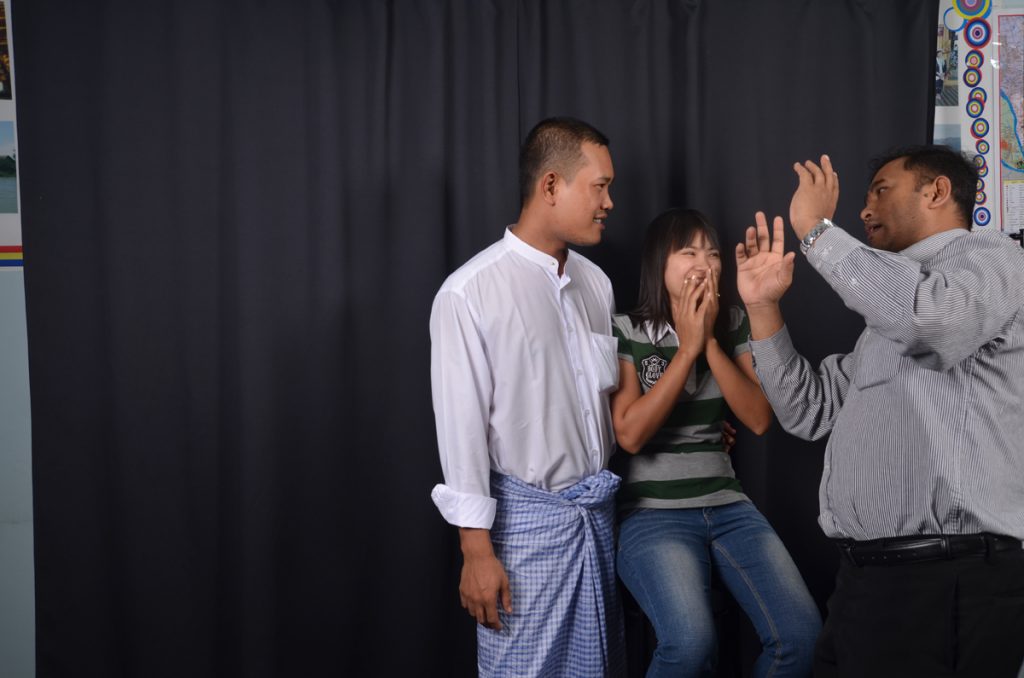 |
| Behind the scene of "As if, Hope (2013)"; photo courtesy of Okui Lala |
When we position ourselves to the public, I think it is important to have exhibitions or some kind of public viewing. It is important to the participants, and sometimes they will ask us why so few people come. Clearly they care about what they have to say and an audience is important to them. In my project on migratory culture, I get questioned a lot about whether I’m Burmese, why I care, and if I want the Myanmar or Bangladeshi workers to become a core nationality in Malaysia. In a 众 mentality, people start to care about things and issues bigger than themselves. For instance, in Malaysia,we finally got comfortable being the third generation living here as Malaysian, and now the new migration wave has begun, and new problems and compromises are emerging for some.
4. From late 2012 to early 2013, I started off by documenting the “non-locals” (migrants) in the city. It was a work (As If, Hope, 2013) for an exhibition in my university, responding to the exhibition’s theme on urbanization. I was recording the faces of migrant workers, seeing it as being very beautiful portraits of the city when captured in slow motion. However, others saw different things in my work. I was surprised that my classmates asked if they were refugees and illegal! During that time in 2013, it was a sensitive period politically as the opposition parties were very close to toppling the current ruling party. It was reported that some political party gave out a lot of IDs to the Bangladesh workers so that they could actually vote for them. This has built up even more xenophobia in the country and migrant workers often become the victims in these cases. Later, I continued some NGO work, where I was involved in documentation to support their cause. In the process I felt that art could not necessarily solve problems, but it could offer a softer way and provide alternative narratives to a situation.
As I made my frequent trips to a small Myanmar community in the city centre, I met more people and started to talk to them. Most of them are only able to converse in simple Malay, thus deeper conversation was hard for me until I met Bo Mya, who became my “middle-person” and translator. He helps to run a travel agency and conducted free language classes for the Myanmar kids there. In January 2013, I did a portrait session at his place whereby I photographed over sixty persons from their community in a day. It was popular because selfies were not so common then, so having a printout of a portrait meant something. In April 2014, I visited Bo Mya again. I was so surprised when he told me that more than half the people that I’d photographed had left Penang for other places. I then decided to make a project with them again, to talk about the ebb and flow of migration happening in the city. Unfortunately, Bo Mya himself decided to go back to his country to settle down in 2015. Before he left, he introduced me to his best friend, Steven Nyi Nyi, who also, like him, has worked and stayed in Penang for the past twenty years. Steven speaks good Hokkien, Malay and English.
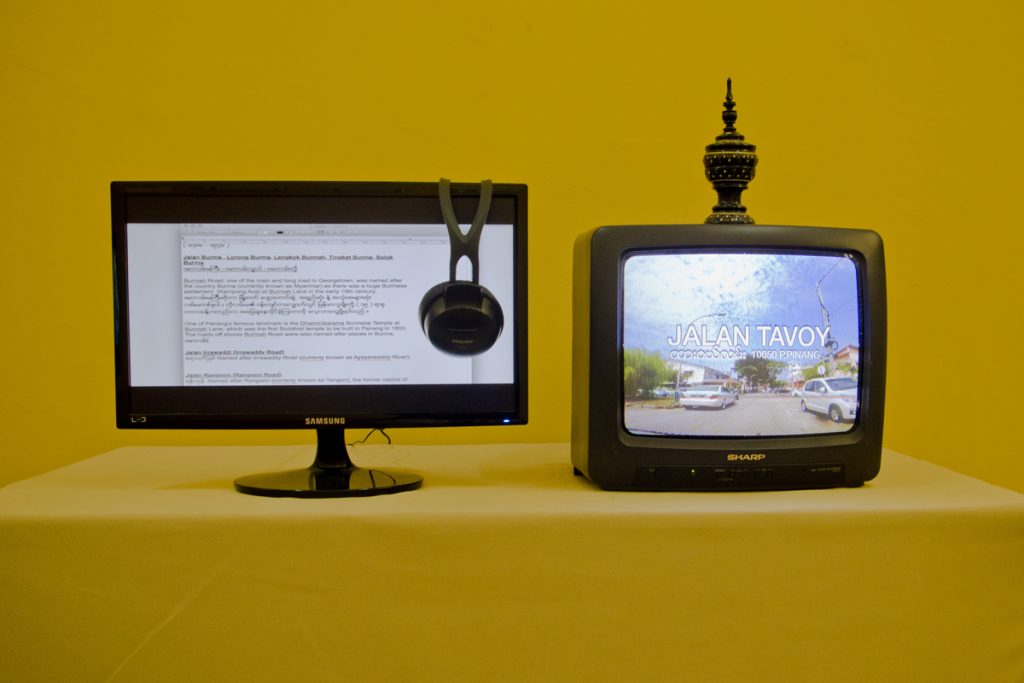 |
| Okui Lala, "Translating (2015)"; photo courtesy of artist |
When I first talked to Steven about doing an “art project” together, he suggested to look into the road names in Pulau Tikus, Penang, whereby eight roads were named after places in Burma (Myanmar) during British colonization in Penang. Penang, being a vibrant port back then, attracted people from around the world. There was a large Burmese settlement at Pulau Tikus in the late 18th century.[4] For Steven, the road names, Burmese temple and the traces of history in Penang are some of the reasons he felt attached there. The working process with him was interesting because all the information of the road names found online was available in English only. Steven translated the text into Burmese and got another friend, Zay to type his hand-written notes into Burmese ("Translating", 2015). He then shared the information on social media with his friends.
Another work that we did together was the video work about Burmese Tea Salad – Laphet Thorke. Historically, Laphet Thorke was served as a peace offering dish after a dispute between kingdoms; nowadays it serves as a snack and welcoming dish to guests. In "Let’s Drink and Eat Tea!" (2015) [5], we engaged Steven’s young and friendly friend Florence Lay, who has worked and stayed in Penang for the past four years. Most of my conversations with Florence were in simple Malay, which she learned while working in the factory here. Steven, on the other hand, speaks fluent Hokkien, a local dialect commonly used among locals in Penang, along with speaking basic Malay and English. Steven has many local friends because of his language ability, thus, he adapted well in Penang. Here, I found that language tells much about one’s migratory history and the demography of a society too. For instance, how did I end up knowing five languages? When and why do I use one language? Therefore, in one of the videos, I performed alongside with Steven and Florence to make a Burmese Tea Salad tutorial.
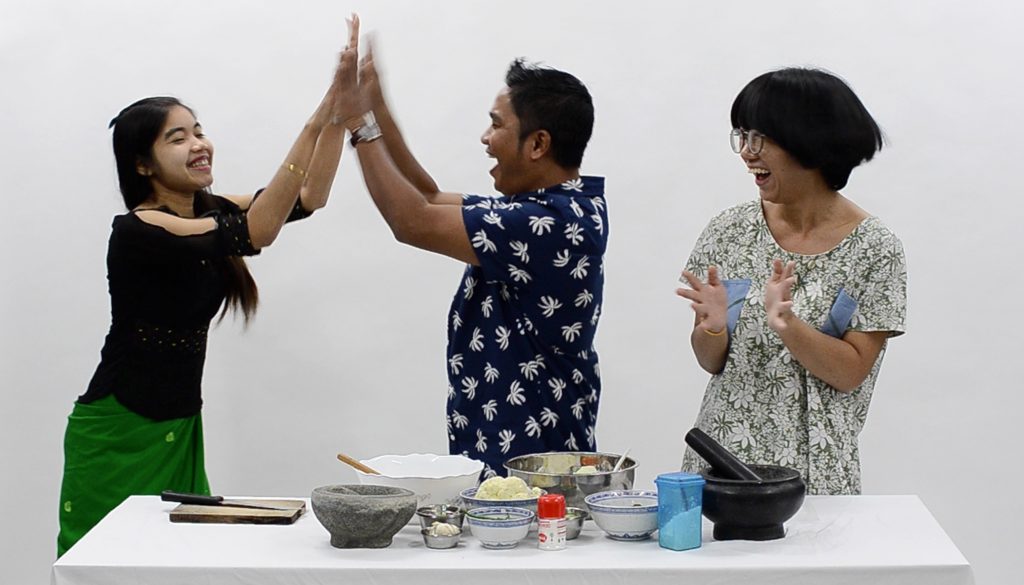 |
| Okui Lala, "Let's Drink and Eat Tea! (2015); photo courtesy of Okui Lala |
5. Our working process and relationships was not meant to be controlled and the process evolved over time. It was my first project on migration. When I started the project I was asked frequently by others if my portraits would affect this community negatively, as it would be exposing them. It was a very diverse community, with different ethnicity, and I had no idea whether they were legal or not. The feedback I was getting from others made me very self- conscious as well, and I even stopped the project for a year. But later I asked some of the participants of the portrait shooting section what they thought of my concerns. They were not worried because the photos’ background did not show where exactly they were and it didn’t portray them doing business. According to them, when I first started to make my frequent trips to their community, news spread among them that there was a girl with a camera interested in them, and I noticed that I was being observed as well. As I gradually gained their trust, I also learned that they had a strong support system as well. They would gather for festive occasions and try to contribute back to their community. For example, they organized donations during the Myanmar flood of 2015.
In 2014, a lecturer of mine, Yap Sau Bin, who has been following my work and progress, encouraged me to return to this work and keep the conversation going with them, now that I have more experiences working in projects involving people and context. When I returned, I was shocked to find most of the Myanmar shops were closed and so many of them were not there anymore. It made it even more important to continue to work on it. Was it really due to political or economic reasons that they were leaving?
6. In 2015, Malaysia-Thailand-Indonesia-Myanmar were caught-up in the Rohingya refugee conflict and crisis. The governments from all countries reacted slowly and were pointing fingers at each other. The public started to show concern about the issue when a refugee boat was very near to the Malaysian shoreline. At the same time, there was also the European refugee crisis. For a while, news and headlines were constantly reporting on both the crises in SEA and Europe. Eventually, the public interest faded as the news feeds shifted focus. It made me think about how we treat our migrants in our daily lives? If there is xenophobia in our everyday society, how would we even be able to deal with a refugee crisis? In Penang, where we take pride in our multicultural city and history, it is shocking that sometimes our leaders behave in racist ways. For instance, it was in the news that our leaders said publicly that migrant workers should not be allowed to cook in Penang eatery outlets, as it would affect our quality of food and heritage.[6]
I was then invited to do an artwork responding to the ebb and flow of the city for Digital Arts and Culture Festival,[7] as part of the George Town Festival 2015 program. The venue of the festival was at the Penang State Art Museum. I approached Steven and his friends for this project. They were quite excited because of the venue and were very willing to participate. It became a win-win situation, for both Steven and I had a clear idea of what we would like to get from the project: I wanted to explore the different narratives of migratory culture, while Steven wanted to talk about the richness of Burmese culture in Penang. That was how we got into using food as a medium. He said, ”Do you know why Burmese food is not as famous as Thai food?” and then he related it back to history when Myanmar was closed off and not used to foreign style. The food was not adapted to a more “universal taste”. Burmese food often regards as too salty or too oily. He believes that it could be as famous as Thai food with some adaptation. My project was a way for him to reach out to the public in Penang, and I was also interested in the public responses.
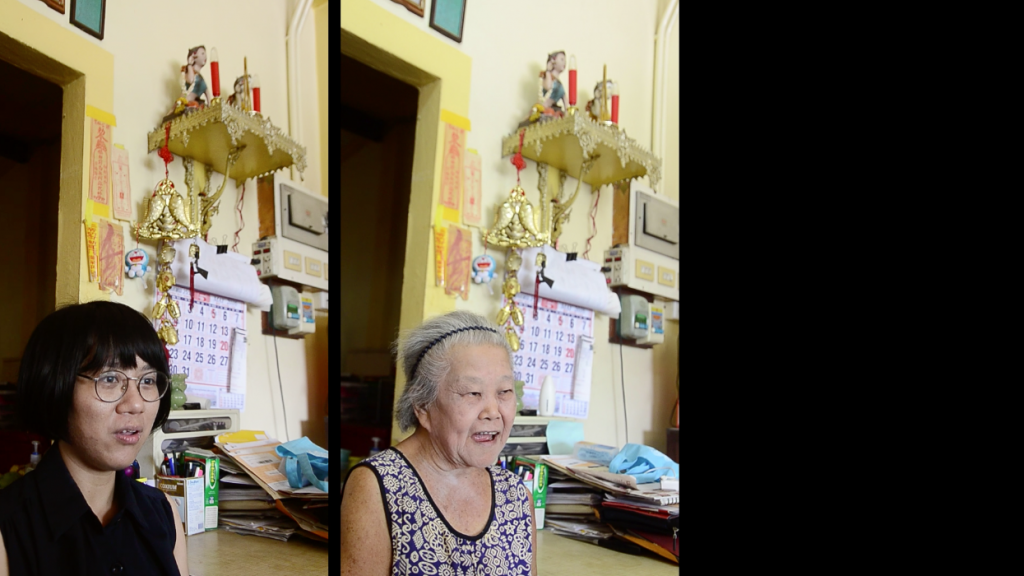 |
| Okui Lala, "How do we meet? How can we meet? (2016)", photo courtesy of Okui Lala |
7. “What is the role of translation in my art practise and how does it affect my work?” - I think for me, translation is not only between languages. It travels through various forms and mediums. Even within the same language, the interpretation may vary among individuals. In “Let’s Eat and Drink Tea!” (2016), I see the process of translation as a movement of migration and the Laphet Thoke as the medium to contain the languages. Burmese was used to introduce the Burmese Tea Salad in the beginning followed by the translation in Hokkien, Malay and in the end English. The information may reduce after moving from one language to another or transfer into another meaning and interpretation. Likewise, for Baan Noorg’s 365 Days: LIFE MUSE[8], in my video performance with Pa Im in “How do we meet? How can we meet?” (2016) [9] our narrations and actions were translated from one language to another. Translation may be of the same thing or not, as the context and background of the language itself are different. In both aforementioned works, translation is akin to culture transfer for me. However, looking at an individual’s multilingual characteristics, where and when does the translation occur? So I decided to have a panel discussion with myself (x4) in the languages I know.
My earlier experiences of translation were through the transferring of languages among individuals. In “How do we meet? How can we meet?” Both subjects were using two different languages (Thai, Teochew) (Mandarine, Teochew) and met in one of them. How about the gaps and meeting point of the 4,5 languages that I have acquired? They are translation of myself too, a process that occurs within. When I am using languages as my tool, the languages itself contains its own distinct accents, language politics and the unwritten. Therefore, when we were using the same word, are we talking about the same thing or in another words? Are the signifier and signified (Ferdinand de Saussure) the same? When I was attending the Taiwanese language class during my residency, I found the language is something very close to my home’s (Penang Hokkien). The sign is similar, but I wonder if the signified is my signifier or vice versa due to the cultural difference between Taiwan and Malaysia. The development of Taiwanese language was also halted for a period therefore there are some gaps between the language and time. When a word can’t be written out, Taiwanese Romanisation System will be used. In Penang, Malaysia, even though there is Penang Hokkien Romanisation System, a lot of us can’t even pronounce it as its not taught in school and not commonly used nowadays. The gap we are facing is wider along with mixtures of other languages and pop cultures like the influence of Taiwanese TV drama and songs on Penang Hokkien. I wonder what will be of Penang Hokkien in the future? While in Taiwan, what will be the effects of the inclusion of native (Taiwanese, Hakka, Aboriginal languages) and new immigrants’ languages (Southeast Asia languages) class in Taiwan education curriculum even though it is only a once-in-a-week class. I'm curious about this ongoing “translation” process.
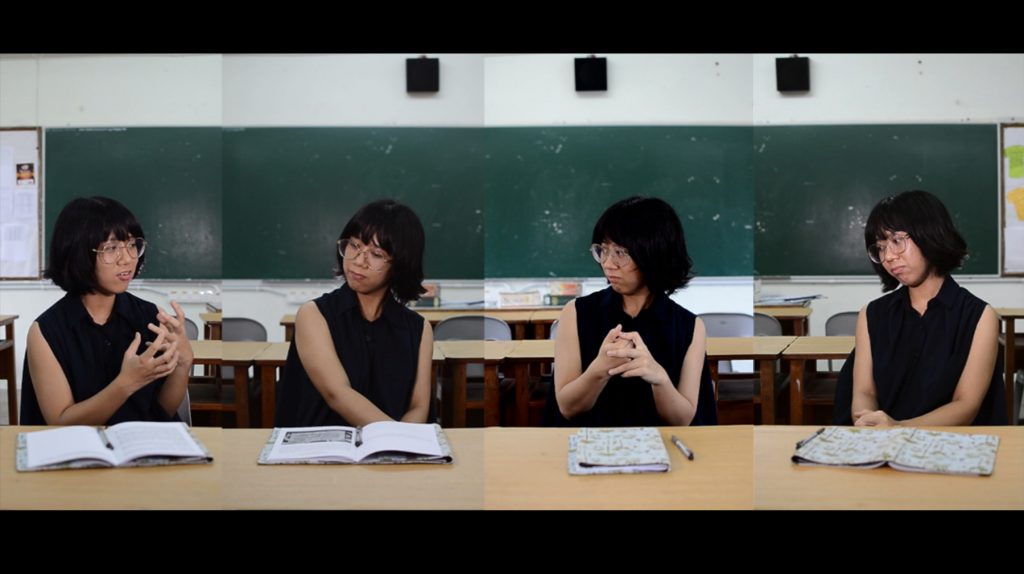 |
| Okui Lala, "My Language Proficiency (2017)"; photo courtesy of Okui Lala |
8. Because I have migratory roots: my multi-ness, confusions and mixtures are also due to this background. Whether “Nusantara” or “Malay archipelago” is a collective identity, it is certainly one of my considerations during this residency. One of the triggering points during my stay was when Bahasa Malaysia assumed as Bahasa Indonesia. Yes and no, considering regionalized and localized varieties. But having “Bahasa Melayu as a tool,” it does allow me to connect with the Indonesians in Taiwan. Another similar experience was with Hokkien- even though in my language proficiency, my Hokkien is the least fluent, but it became my connector with my Taiwanese teacher and fellow classmates. Within the shared language, there are also difference in accents, and that became my connector with fellow Malaysian friends based in Taiwan (different accents in mandarin), which draws another small circle in a larger one. In one of the talks I attended at Brilliant Time, the speaker shared that the standard Vietnamese language he learned can’t be used in all parts of Vietnam because of the difference in regional varieties (or dialects). Every country including Taiwan and Malaysia has the similar situation. When languages are standardised or systemised, they create another distinct recognisation.
When languages become my tool, they also drew the boundaries and outreaching. As a Malaysian with a Chinese migratory background, we assimilate or adapt easily in Taiwan; but there is also another Southeast Asian identity we need to readjust. I would like to take Wong Wen Su, a Malaysian artist based in Taiwan, for example. In his recent solo exhibition at Taipei Artist Village, Wen Su exhibited the application of his father to become a Malaysian nationality. His father is not yet a Malaysian to date as he didn't manage to apply immediately right after the Malaya independence. According to Wen Su, he thought that his father might have given up on this identity, but to his surprise, during his recent trip back home, he realized that his father was still applying and clearly it mattered to him. I wonder how much these identities and sentiments will resonate with the wider audiences in Taiwan? Wen Su said that some Taiwanese audience could relate through certain signs and metaphors. On the other hand, we wonder that if his art practice in Taiwan is able to resonate with the Malaysian audience back home due to the difference in the signifier and signified in both place.
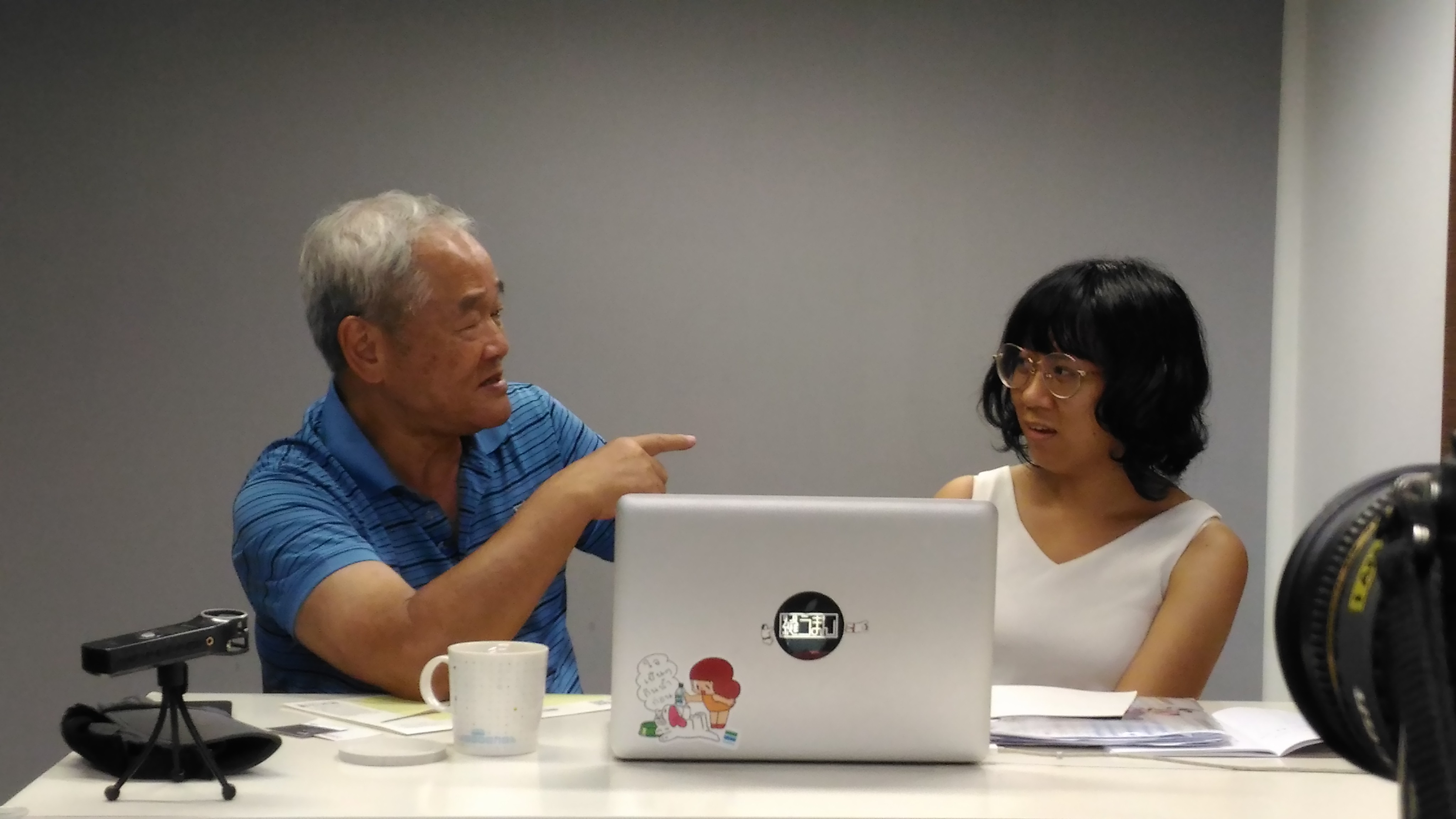 |
| In the disccusion for "A Proposal for Our Future Mother Tongue (2017)"; photo courtesy of Okui Lala |
The conversation with the Taiwan-based Malaysian artists is interesting too as we are also cultural migrant workers in a way. When we are transferring ourselves from a place to another we were as if the middle person or translator looking for the suitable signifier and signified. How do we meet in the complexity of languages and cultural exchange in Southeast Asia + Taiwan? I could imagine a longer queue of translators in “Let’s Eat and Drink Tea”!
Reference:
1. Official MSC Malaysia website, mscmalaysia.my (accessed Aug 1,2017)
2. The Kuala Lumpur Experimental Film and Video Festival, klexfilmfest.com (accessed Aug 1,2017)
3. Arts-Ed, “Community based Arts & Culture Education”, www.arts-ed.my (accessed Aug 1,2017)
4 Heritage Spots of Pulau Tikus, en.wikipedia.org/wiki/Pulau_Tikus (accessed Aug 1,2017)
5. “ Let’s Eat and Drink Tea!” (2016), cargocollective.com/okuilala/Let-s-Drink-and-Eat-Tea-2015
6. Ahmad Fazal, “Inhumane to ban foreign cooks”, www.thestar.com.my/news/nation/2014/08/16/inhumane-to-ban-foreign-cooks-we-urgently-need-a-new-paradigm-in-the-way-we-manage-and-treat-migrant/ (accessed Aug 1,2017) 7. Digital Arts and Cultural Festival, www.dacfestival.com/2015-.html (accessed Aug 1, 2017)
8. Baan Noorg Collaborative Arts & Culture; 365 Days: Life Muse, (fb) www.facebook.com/events/1789787264630645 (accessed Aug 1, 2017)
9. “How do we meet? How can we meet?” (2016), cargocollective.com/okuilala/How-do-we-meet-How-can-we-meet-2016
沒有留言:
張貼留言